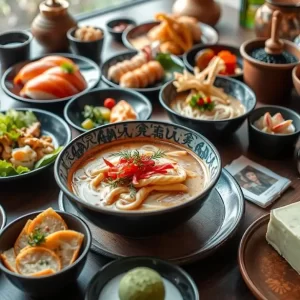Have you ever tried deep-fried shrimp still in their shells? Or coffee made from beans heated by volcanoes? From Japan’s sticky natto to Kenya’s banana flambé, there’s a world of flavors to explore. This guide introduces 11 extraordinary dishes that will challenge your taste buds and share their fascinating stories.
Picture dining in Dubai’s Chillout Ice Lounge at -21°F or enjoying shark meat in the Caymans. These dishes are more than just food; they’re pieces of history. Whether you’re making a Kamayan buffet at home or thinking about volcano-cooked meals, this is where your culinary journey begins.

Key Takeaways
- 11 global foods reveal hidden cultural histories and survival traditions
- Natto’s fermented soybeans offer stroke prevention benefits
- Geothermal-cooked meals in Spain show nature’s role in cooking
- Stinky tofu’s pungency mirrors Southeast Asia’s fermentation mastery
- Adventure foods like rattlesnake or jellyfish teach texture innovation
The Rising Trend of Culinary Adventures and Exotic Food Tourism
Exploring global flavors has become a key part of modern travel. More than 88% of travelers now look for delicious international dishes when planning trips. This shows a desire to go beyond the usual tourist spots and really connect with cultures through food.
Why Food Has Become the New Frontier for Travelers
Food tourism is more than just eating. It’s about discovering new things. Platforms like Instagram show authentic italian pasta dishes at home or easy dinner ideas from locals. This turns recipes into travel guides.
Cookbooks and step-by-step guide to baking sourdough bread help bring global flavors home. They bridge the gap between where we are and where we dream to be.
How Social Media Has Transformed Food Exploration
- Hashtags like #exoticfood turn viral trends into travel itineraries.
- Influencers share comfort food favorites from remote villages, making them aspirational.
- Live videos of delicious comfort food cooking tips demystify unfamiliar ingredients.
The Cultural Significance of Trying Local Delicacies
Trying cookbook recipes like balut or hákarl is more than adventurous. It’s a sign of respect for culture. These dishes tell stories of survival, tradition, and community.
For example, century eggs in Chinese cuisine symbolize patience and heritage. By trying these foods, travelers show respect for the stories behind each bite.
| Traditional Dish | Cultural Meaning |
|---|---|
| Hákarl (Iceland) | Adaptation to harsh climates |
| Balut (Philippines) | Historical preservation techniques |
Whether enjoying comfort food favorites or learning easy dinner ideas from abroad, exploring food builds cultural bridges. Every bite teaches us about history and humanity.
Understanding the World of Exotics: Beyond Your Comfort Zone
Exploring exotic foods is a journey that pushes your taste buds. Foods like rambutan or dragon fruit might look scary at first. But, their bright colors and special tastes open doors to flavors from around the world. Let’s take a look at how to start this exciting culinary adventure.

- Start small—pair unfamiliar ingredients like Buddha’s Hand citrus with familiar staples in easy vegan breakfast ideas, such as oatmeal or smoothies blends.
- Experiment with dinner recipes using visually striking options like star fruit in stir-fries or mango-like mangosteen in salads for quick dinner ideas.
- Pair tangyiness of kiwi or pomelo with everyday meals to build familiarity without overwhelming your taste buds.
Psychology also plays a part. Our brains can be hesitant about new textures or smells. Try drizzling yuzu over tofu for a zesty twist in quick dinner ideas. Even a small bite of Mexican guava in a yogurt parfait can spark curiosity in easy vegan breakfast ideas. Remember, even “exotic” foods were once new to everyone.
Cultural background matters too. Kiwi’s Chinese roots or mangosteen’s health benefits add depth to your meal. As you try new things, your taste buds will adapt. What seems strange today might become a favorite tomorrow. Let’s enjoy exploring one bite at a time.
Casu Marzu: The Controversial Maggot Cheese from Sardinia
Casu Marzu is a cheese from Sardinia that sparks debate. It has a core of live insect larvae. This cheese is a mix of tradition and controversy, caught between cultural heritage and modern food safety.
The Fascinating Production Process
It starts with raw sheep’s milk turned into pecorino. Then, it’s left to get infested with cheese flies. The eggs hatch into larvae that break down fats. The process includes:
- Uncured pecorino cheese is left to ferment outdoors
- Larvae digest fats, creating liquid “lagrima” (tears)
- Maturity reached when cheese becomes creamy and pungent
Taste Profile and Serving Suggestions
“The first bite is an explosion—like tasting time itself,” says local cheesemaker Maria Andreu. “It’s not just food; it’s a dialogue with nature.”
The cheese has sharp ammonia and fruity flavors. It’s best with crisp pane carasau bread and Cannonau wine. For those who prefer milder tastes, try aged pecorino with grappa. For bold flavors without insects, check out savannah ryan’s comfort food creations for dishes with intense umami.
Legal Status and Where to Find It
The EU bans it because of the live larvae. But Italy protects it for cultural reasons. To legally try it, visit Sardinia’s rural areas in June-September. Sales are often hidden through local networks. For those who can’t go, savannah ryan’s best recipe cookbook collection has easy dinner ideas with Mediterranean flavors. Choose healthy snacks like marinated olives or aged cheeses for similar tastes without the risks.
Balut: The Fertilized Duck Egg Delicacy of Southeast Asia

Balut is a beloved comfort food in the Philippines. It’s a fertilized duck egg boiled and served with salt or vinegar. This street food is a big part of Southeast Asian culture. It’s a protein-rich snack that’s been around for centuries, great for a quick meal.
The history of balut goes back to the 16th century, thanks to Chinese traders. By the 1950s, Pateros, known as the balut capital, had 400,000 ducks a year. Its fame grew in the early 2000s after being featured on Fear Factor and Survivor. You can read more about it here: exploring global comfort foods. Today, it’s still a symbol of tradition, loved for its creamy yolk and unique texture.
- Nutrition: 14g protein per egg—more than beef jerky.
- Cultural role: Seen as an aphrodisiac and a nutritious choice for expectant mothers.
- Global recognition: Pateros’ 2015 Guinness World Record for the largest balut adobo dish (117.5 kg).
While some might choose cookie recipes or easy weeknight meals, balut invites you to discover global flavors. It’s easy to make: just boil, crack, and enjoy with salt. Despite the trend towards Western diets, balut remains a cultural icon. It shows the Philippines’ rich culinary heritage. Whether you’re a seasoned traveler or a curious home cook, balut offers a taste of tradition that crosses borders.
Hákarl: Iceland’s Fermented Shark That Challenges Even the Bravest Foodies
Exploring global cuisine often means facing the unknown. Iceland’s hákarl is a perfect example. This fermented shark dish is more than a curiosity—it’s a survival legacy. It shows how humans can turn toxic raw ingredients into cultural treasures.
Traditional Preparation Methods
Greenland shark meat, toxic by nature, is fermented for 4-5 months. First, it’s buried in gravel for 6–12 weeks to remove toxins. Then, it’s air-dried for months in coastal sheds. This ancient method creates a firm, ammonia-rich texture. Learn more about the process here.
- Bury in gravel beds to remove toxins
- Air-dried for 4–5 months
- Served as small cubes with Brennivín
Cultural Significance in Icelandic Heritage
Hákarl has Viking-era roots, becoming a key part of the Þorrablót winter festival. The phrase þetta reddast (“it will work out”) reflects this dish’s spirit—turning adversity into tradition.
Anthony Bourdain called it “the most disgusting thing I’ve ever eaten,” yet Icelanders view it as a point of pride.
Today, producers mix tradition with safety, as noted inthis analysis of its cultural role.
| Fact | Details |
|---|---|
| Key Ingredient | Greenland shark (400-year lifespan) |
| Fermentation Time | 6 weeks burial + 4 months drying |
| Traditional Pairing | Icelandic Brennivín schnapps |
Tips for First-Time Tasters
Approach this delicacy with curiosity!
- Hold your nose to minimize ammonia odor
- Start with a small half-inch cube
- Chase with rye bread or fruit to balance
- Visit the Bjarnarhöfn Shark Museum for context before tasting
Remember: the goal isn’t just taste—it’s experiencing a living tradition.
Durian: The Infamous “King of Fruits” with an Unforgettable Aroma
For those who love to try new foods, durian is a must-try. It has a strong smell and taste that people either love or hate. But, its creamy texture and sweet flavor make it a great choice for easy dinner ideas.

- Monthong (Golden Pillow): Mild, sweet, and creamy—ideal for healthy recipes seeking natural sweetness.
- Musang King: A crowd favorite for its rich, buttery flavor and soft texture.
- Udang Merah: Milder aroma and sweeter flesh, perfect for beginners.
Begin with small amounts! Weight loss tips by the kitchen foodie suggest blending durian into smoothies bowls or mixing it with coconut milk. Start with ice cream or candies to get used to its taste.
Durian is good for you, with lots of potassium and vitamin C. But, it’s high in sugar, so eat it in moderation. Adding herbs like lemongrass or coconut can help balance its flavor. With a little patience, durian can become a favorite in your kitchen.
Fugu: Japan’s Deadly Pufferfish Requiring Expert Preparation
Fugu is a thrilling and traditional Japanese dish. Its preparation is a delicate art that requires skill to avoid deadly toxins. Yet, its subtle flavors offer a unique culinary experience.
Fugu contains a potent neurotoxin called tetrodotoxin, which is up to 1,200 times more potent than cyanide.
The Rigorous Training of Fugu Chefs
To become a fugu chef, one must study for years. Here’s what it takes:
- 3+ years of apprenticeship under certified chefs
- Written and hands-on exams with a 35% pass rate
- Training to identify 20+ species and toxic organ locations
Even after passing, chefs must follow strict rules. They must dispose of toxins in special containers. They also avoid the liver, banned since 1984 for its extreme toxicity.
The Unique Flavor and Texture Experience
Fugu’s taste is best in simple dishes like sashimi (tessa). Its slices are firm yet creamy. It’s light sweetness pairs well with soy sauce or citrus, making it perfect for quick dinner ideas in fancy places. Some say there’s a subtle tingle from trace toxins, but properly prepared dishes are safe.
Where to Safely Try Fugu in the United States
In the U.S., options are few but growing. These homemade recipes for every occasion can’t be made at home. But these restaurants offer certified experiences:
- NYC: Morimoto, Brushstroke (winter seasons)
- LA: n/naka, Urasawa (reserve 6 months ahead)
- San Francisco: Wako’s omakase menus
Always check for licenses in restaurants. This ensures the chef is certified. Prices start at $150 per person for multi-course meals.
Escamoles: Mexican Ant Eggs Known as “Insect Caviar”
Escamoles, the larvae of black ants, have been a cherished part of Mexican cuisine for centuries. These delicate morsels, harvested from agave roots, offer a buttery taste with nutty undertones. Found in central Mexico, they’ve earned their “insect caviar” title due to their creamy texture and rarity. Their short harvest window—from February to April—makes them a seasonal treasure in dinner recipes and the kitchen foodie recipes.

Traditionally sautéed with garlic and epazote, escamoles star in tacos or omelets. Modern chefs blend them into soups or serve them with guacamole. For home cooks, try these ideas:
- Top chicken recipes with escamoles for a protein-packed twist.
- Stir into warm tortillas with salsa for a quick taco filling.
- Pair with queso fresco in enchiladas for a rustic yet elegant dish.
Respect for tradition guides their harvest, ensuring sustainable practices. Supporting local communities means enjoying these ant eggs ethically. As this report highlights, escamoles balance culinary heritage with economic livelihoods. Whether in tacos or creamy dishes, they’re a gateway to Mexico’s rich biodiversity. Start exploring these tiny delicacies—your taste buds and your kitchen foodie recipes will thank you!
The Health Benefits of Incorporating Exotic Foods into Your Diet
Adding global ingredients to your kitchen is more than fun—it’s good for your health. Foods like durian and balut have nutrients not in regular diets. They can boost your immune system, help with digestion, and even make you happier.
For tips, check out global recipes at the kitchen foodie. We have guides like step-by-step guide to baking sourdough bread with exotic flours. Let’s look at why these foods are so beneficial:
Nutritional Profiles of Unusual Ingredients
Unusual foods have special health benefits. For example, exotic vegetables like dragon fruit are packed with antioxidants and vitamin C.
- Dragon fruit: Antioxidants and vitamin C for immunity
- Açai: Omega-3s and fiber for heart health
- Passion fruit: Natural electrolytes balance with potassium
Even insects like cricket flour are full of calcium and iron. They’re great for healthy gluten-free dessert ideas or easy weeknight meals that are both tasty and nutritious.
Building a Stronger Microbiome
Diverse foods are good for your gut’s microbiome. Fermented foods like hákarl or kimchi add probiotics missing in regular diets. Studies show foods like Indonesian tempeh improve digestion and immunity.
For home cooks, try:
- Incorporate baking recipes using exotic flours
- Add fermented condiments to breakfast ideas like yogurt bowls
Psychological Benefits of Culinary Exploration
Trying new foods like century eggs or escamoles sparks curiosity. Neuroscientists say new flavors create brain pathways linked to creativity and less stress. For ideas, check Savannah Ryan’s best recipe cookbook collection.
Exploring global ingredients can also make you more resilient. Every new dish is a victory for adaptability!
| Ingredient | Key Nutrient | Health Impact |
|---|---|---|
| Dragon Fruit | Vitamin C | Immune support |
| Açai | Omega-3s | Heart health |
| Coconut Water | Electrolytes | Hydration |
Begin with small changes: use dragon fruit in smoothies or add cricket flour to cookie recipes. Every bite strengthens your body and sharpens your mind.
Century Eggs: China’s Time-Transformed Preserved Delicacy
Century eggs, or pidan, are a wonder of Chinese tradition. Made from duck, chicken, or quail, they soak in clay, ash, salt, and lime for weeks. This process turns them into a gelatinous white and a rich, dark yolk with a deep flavor.

These eggs are great for easy vegetarian dinner recipes for beginners. Their unique taste is perfect in comfort food favorites like warm rice porridge or with soy sauce. Slice them over noodles or mix into tofu salads for a quick and affordable weeknight meal.
- Serve with pickled ginger or chili oil for a balanced bite
- Add to stir-fried vegetables for umami depth
- Use in soups to enhance broth flavors
At 9g protein per egg, they’re full of nutrients but high in sodium. So, pair them with fresh ingredients. You can find them in Asian markets or online. They’re affordable and last up to 3 months unopened. Always check for a clean, earthy smell before eating; avoid any ammonia or strong urine smells.
We suggest starting with small portions to get used to their taste. Once you’re comfortable, century eggs become a key ingredient for creative meals.
How to Find Authentic Exotic Ingredients in American Cities
Exploring global cuisine starts with finding authentic ingredients. Stores like Green 2 Go Wellness in Kennewick have over 200 healthy snacks from five countries. They offer Lay’s Italian Red Meat chips and Oreo Matcha Fig. These markets make exotic ingredients easy to find for quick meals or vegan breakfasts.
| Market | Location | Specialties |
|---|---|---|
| 99 Ranch Market | Coastal cities | Asian fermented products, century eggs |
| Uwajimaya | Pacific Northwest | Japanese and Korean pantry staples |
| El Mercado Central | Phoenix, AZ | Latin American ant eggs (escamoles), regional chilies |
Online sites like Exotic Meat Market and Marky’s make it easy to order rare items. Look for subscription boxes with international flavors. Always check state laws—some items need permits for shipping.
- Visit cultural festivals like Miami’s Mango Festival to try dishes like durian desserts
- Join cooking workshops at markets like New York’s Kalustyan’s for tips
- Follow the kitchen foodie recipes for brownies and baking with global spices
Local farmers markets have vendors from immigrant families selling fresh ingredients. Use these with quick cooking tips from Kitchen Foodie to make international dishes at home. Every exotic ingredient has a story to tell, waiting to be cooked.
Surströmming: Sweden’s Fermented Herring with the World’s Most Challenging Smell
Sweden’s surströmming is not for the faint of heart. This fermented Baltic herring is known for its strong smell. It’s a dish steeped in tradition, found in cookbooks like Nordic Flavors. Even the bravest cooks find it a challenge.

The journey begins with lightly salted herring fermented for 1–2 months. The cans swell as gases form, a sign of aging. Opening them outside is crucial, as the smell can be overwhelming.
Despite its pungent aroma, the taste is surprisingly balanced. It combines salty, sour, and umami flavors when paired correctly.
- Traditional serving: Thin rye bread (tunnbröd), diced onions, sour cream, and mandelpotatis (small potatoes)
- Outdoor etiquette: Always open cans outside—many airlines and rentals ban it due to its odor
- Flavor balance: Pair with crisp beer or aquavit to cleanse the palate
| Aspect | Fact | ||
|---|---|---|---|
| Peak season | Served August 18th (Surströmming Day) | ||
| Key ingredient | Baltic herring | Traditional pairing | Swedish flatbread and sour cream |
Even those skilled in chicken recipes might find this a bold challenge. Yet, its cultural significance is important. Many online retailers like ScandiKitchen sell it all year.
For those who are sensitive to smells, start with a small amount. Serve it with familiar sides to balance its intensity. Remember, tradition demands respect—enjoy it as part of Sweden’s culinary heritage.
While cookbook recipes often suggest eating it outside, modern tasters experiment with creative twists. Yet, respect its heritage: this is a dish to savor with open minds and open windows.
Transforming Exotic Ingredients into Approachable Home Recipes
Adapting exotic ingredients doesn’t mean making dishes exactly the same. Start small by adding finely diced century egg to deviled eggs for a healthy recipes twist. Blend durian into smoothies to balance its strong aroma, or mix escamoles into omelets for a gentle introduction. These strategies turn unfamiliar flavors into international recipes that feel familiar yet adventurous.
- Use easy dinner ideas like durian caramel sauce over ice cream or hákarl in chowder for layered flavor.
- Pair exotic elements with comfort foods—think boeuf bourguignon with wild mushrooms or chili made with cricket flour.
- Experiment with condiments: Try century egg aioli or ant caviar-infused pesto.
“The best way to embrace new ingredients is through dishes you already love,” says Chef Lila Nguyen, author of Savor the World. “Start with small portions and adjust seasoning gradually.”
Record taste notes to track what works. For example, our testers found that simmering fermented shark in broth muted its intensity. Explore weight loss tips by the kitchen foodie by substituting half the cheese in mac & cheese with jackfruit for creaminess. Always prioritize balance—let the exotic ingredient enhance, not overpower. Remember, even classic Caesar salads began as ingredient experiments. Your kitchen is a lab—explore fearlessly.
Kopi Luwak: The Controversial Coffee Processed by Civet Cats
Exploring global recipes often leads to unique ingredients. Kopi Luwak is one such example. It’s famous for being fermented in civet cat intestines. But, its luxury status hides animal welfare concerns and high prices.

Production Ethics and Animal Welfare
Wild civets eat coffee cherries in traditional methods. But, modern farming keeps them in small cages. This causes stress and health problems.
Certified wild-sourced beans are rare. This makes finding real kopi luwak hard. The demand for it leads to fake products, with up to 80% being counterfeit.
Taste vs. Cost
Kopi Luwak costs $220-$1,100 per kilogram. Yet, its taste doesn’t match its price. It’s smooth but lacks the complexity of other specialty coffees.
Many prefer the taste of step-by-step guides for roasting or brewing. Resources like Savannah Ryan’s comfort food creations offer better options.
Ethical Alternatives
Here are some ethical coffee choices:
- Enzymatic-processed beans mimic digestion without animals
- Ethically sourced Indonesian single-origin coffees
- Try home roasting with healthy dinner recipes for coffee pairings
| Option | Ethical Score | Flavor Profile |
|---|---|---|
| Wild-sourced kopi luwak | Low availability | Smooth, earthy notes |
| Enzyme-processed beans | High | Similar acidity reduction |
| Small-batch fair-trade coffees | Best | Regional flavor complexity |
Home chefs can enjoy more by mastering step-by-step guide to baking sourdough bread or healthy gluten-free dessert ideas. These are more rewarding than kopi luwak. Opt for coffees that respect tradition and animal welfare.
Ethical Considerations When Exploring World Exotics
Exploring global cuisine can connect us to other cultures. But we must make choices with care. Here’s how to enjoy exotic foods while being ethical:
First, focus on sustainability. Many exotic foods come from delicate ecosystems. Before trying rare seafood or wild plants, check Seafood Watch guides or the IUCN Red List. Choose farm-raised options with ethical certifications to protect endangered species.
Cultural respect is as important as environmental care. Look for recipes from trusted sources that share origin stories. Supporting producers who respect cultural traditions makes your meals meaningful. This way, you learn and grow while honoring global heritage.
Don’t forget about animal welfare. When picking ingredients like durian or wild mushrooms, make sure they were harvested humanely. Avoid products linked to cruel conditions. Quick, affordable meals can still be ethical with the right choices.
| Consideration | Practical Steps |
|---|---|
| Sustainability | Use Seafood Watch guides for seafood choices |
| Cultural Respect | Learn preparation methods from authentic sources |
| Health Safety | Follow FDA guidelines to avoid zoonotic diseases |
Even easy weeknight meals can be ethical. Choose sustainable options instead of wild-caught to save resources. Always check if ingredients are legal and safe in the US. By doing this, you help protect biodiversity and support fair labor.
- Verify ingredient legality using state regulations
- Choose certified fair-trade spices and specialty ingredients
- Support producers prioritizing humane animal treatment
Every choice we make affects ecosystems and communities. By staying informed, we can enjoy our culinary adventures while upholding ethics. This way, we don’t have to sacrifice convenience or pleasure.
Conclusion: Expanding Your Culinary Horizons Through Global Exploration
Exploring the world through food is easier than ever. With international snacks and drinks, you can taste global traditions from home. Mixing Savor Exotics recipes with simple cooking makes exotic ingredients easy to enjoy. Start with dragon fruit salads or saffron rice to add a modern twist to comfort foods.
International recipes are easy to make. Apps like Cookpad help find global dishes. Plus, choosing ethical ingredients ensures sustainability. Enjoying dishes like jackfruit tacos or marinated bison connects you to cultures worldwide. Even trying new desserts or oils can broaden your culinary world.
Be bold with your flavors but choose ingredients responsibly. Look for international recipes that mix tradition with modern ease. With quick cooking methods and global spice blends, you can enjoy exotic tastes at home. Your next meal could open the door to a new culture—so explore, learn, and enjoy!













